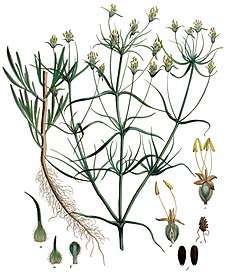Plantago arenaria
Plantago arenaria, commonly known as branched plantain, sand plantain, or black psyllium, is a flowering plant in the plantain family Plantaginaceae, and is one of a few species in the Plantago genus under the common name psyllium.[1] The plant is native to parts of Africa, Europe, Russia, and Asia, and has been naturalized in many other areas such as Australia and North America.[2][3] The plant can be found mostly in dry inland areas, such as those that are sandy, and has also naturalized on roadsides and in meadows.[2][3] The plant is not used broadly as a food source, but has been cultivated for its seeds which serve a medicinal use as a laxative.[4]
| Plantago arenaria | |
|---|---|
.jpg) | |
| Scientific classification | |
| Kingdom: | Plantae |
| Clade: | Tracheophytes |
| Clade: | Angiosperms |
| Clade: | Eudicots |
| Clade: | Asterids |
| Order: | Lamiales |
| Family: | Plantaginaceae |
| Genus: | Plantago |
| Species: | P. arenaria |
| Binomial name | |
| Plantago arenaria | |
| Synonyms | |
|
see text | |
Taxonomy
Two subspecies are recognized: P. arenaria arenaria, the nominate subspecies; and P. arenaria orientalis (Soó) Greuter & Burdet. Each of these subspecies is known under a large number of taxonomic synonyms.[5][6]
Description
Plantago arenaria is an annual herb with a taproot that has an erect stem with leaves that are usually opposite but sometimes in whorls of 3, and elongated internodes between leaf sets.[2][7] Glandular pubescence is found on the stems, leaves, sepals, and inflorescences.[2] The leaves are simple and have a base that is decurrent onto the petiole, an entire or slightly dentate edge, are linear or lanceolate in shape, and can reach 2.5-5cm long and 1-3mm wide.[2][7] Some leaves are modified into bracts between 0.5cm and 2cm which have a cuspidate apex and an orbicular-ovate base.[2] The plant has a densely flowered inflorescence with flowers that have a glabrous, brownish corolla and a calyx with broadly veined, elliptic and obovate sepals.[2][7] The stamens exsert above the corolla, and the anthers are yellow, ellipsoid, and 1.8-2.2mm in size.[2][7] The style of the stigma is also well exserted, and the floral parts are hypogynous but extend superior to the ovary.[2][3][7] The seeds are contained in capsules of 2. The seeds are 2.5-2.8 mm in size, black or blackish-brown, shiny, ellipsoid, and have a distinct central groove on the inner face.[2][7]
Ecology
Plantago arenaria is described as being native to North Africa, Southwest China, Europe, Russia, Kazakhstan, Kyrgyzstan, Russia, and Tajikistan.[2] The plant has become broadly naturalized, identified in areas of Australia, North America, India, Japan, and Pakistan.[2][3] The plant is commonly found in sandy areas such as in arid deserts and on sandy beaches, and has also been seen distributed on roadsides, and by railroad tracks.[2][3][8][9]
Uses

The seeds, known as French psyllium or black psyllium, are medicinally cultivated, along with other species under the psyllium common name, such as P. ovata, for use as a laxative for constipation and are also used to treat irritable bowel syndrome (IBS) and diarrhea by extracting the mucilage from the seed coat.[4][10] The mucilage from the seeds has also been reported to lower the risk of coronary heart disease.[4][10]
References
- "Plantago indica L. — The Plant List". www.theplantlist.org. Retrieved 2020-04-17.
- "FOC Vol. 19". Efloras. Missouri Botanical Garden, St. Louis, MO & Harvard University Herbaria. 2008.
- Jeanes, J.A. (1999). "Flora of Victoria". vicflora.rbg.vic.gov.au. Retrieved 2020-04-02.
- "Black Psyllium: MedlinePlus Supplements". medlineplus.gov. Retrieved 2020-04-02.
- "Plantago arenaria". Catalogue of Life. ITIS. Species 2000.CS1 maint: others (link)
- "Plantago arenaria". Catalogue of Life. ITIS. Species 2000.CS1 maint: others (link)
- Radford, Albert E.; Ahles; Bell (1964). Manual of the Vascular Flora of the Carolinas. United States of America: The University of North Carolina Press. p. 978. ISBN 978-0-8078-1087-3.
- "Plantago arenaria - Michigan Flora". michiganflora.net. Retrieved 2020-04-02.
- "Plantago arenaria | Online Atlas of the British and Irish Flora". www.brc.ac.uk. Retrieved 2020-04-02.
- Hanson, C.V.; Oelke, E.A.; Putnam, D.H.; Oplinger, E.S. "Psyllium". www.hort.purdue.edu. Retrieved 2020-04-02.